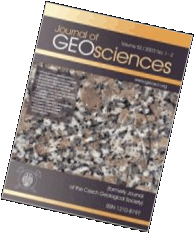 Export to Mendeley
Export to MendeleyOriginal paper
Polytypism of cronstedtite from Chyňava, Czech Republic
Journal of Geosciences, volume 62 (2017), issue 2, 137 - 146
DOI: http://doi.org/10.3190/jgeosci.239
Small druses and isolated crystals of cronstedtite in cavities of a quartz-calcite veinlet were encountered in the borehole drilled near Chyňava (central Bohemia, Czech Republic) in 1943-1944. Single crystals were studied by the X-ray diffraction with aid of the four circle diffractometer with an area detector. The interpretation of precession-like images of reciprocal lattice planes produced by the diffractometer software revealed the polytype 2H1 (of the subfamily - Bailey’s group D) as the most abundant. It occurs either as pure or mixed crystals with minor to negligible proportion of the 2H2 polytype of the same subfamily. Lattice parameters of both polytypes are: a = 5.4907(3), c = 14.1789(9) Å, space groups P63cm (2H1), and P63 (2H2). A crystal of the polytype 3T (subfamily A), twinned by reticular merohedry was sparingly found as well. Another unusual mixed crystal of subfamilies C+A contained the 1T polytype (subfamily C), a disordered portion of the subfamily A except for the apical part of the crystal, and small amount of 3T and possible traces of 6T2 polytypes (subfamily A) in the bottom part. Electron probe microanalysis of selected cronstedtite crystals revealed minor amounts of Cl up to 0.01 apfu (atoms per formula unit), and small amounts of Mg (0.13-0.24 apfu) regardless of the determined polytype.
Webdesign inspired by aTeo. Hosted at the server of the Institute of Petrology and Structural Geology, Charles University, Prague.
ISSN: 1803-1943 (online), 1802-6222 (print)
email: jgeosci(at)jgeosci.org


IF (WoS, 2023): 1.1
5 YEAR IF (WoS, 2023): 1.5
Policy: Open Access
ISSN: 1802-6222
E-ISSN: 1803-1943